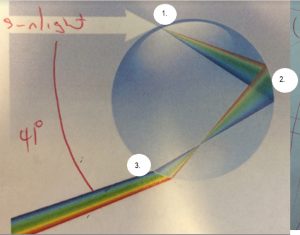For scientists, rainbows are a beautiful, visible manifestation of relatively simple optical physics.
You probably know that a rainbow forms when the sun is behind you, and is low in the sky. And you may have inadvertently created rainbows when spraying a hose in bright sun in your backyard.
You may not know that the same precise mathematical relationship predicts where each rainbow forms, whether ‘natural’ rainbows in the sky or ‘artificial’ in your backyard. Here’s the key: a rainbow forms at a position when the angle from your eyes to the rain and back to the Sun is precisely 41°. See Figure 1 below.

Figure 1. Where to stand if you want to see a rainbow.
All the colours of the rainbow
With rainbows, it is the refraction that provides the colour and the reflection is responsible for the shape – in this case a circle. Yes a circle, not an arch. See Rainbows are Circles below.
When sunlight (as white light) hits a raindrop, it does the following:
(1) refracts (changes direction) as it enters the raindrop – and splits into the different colours
(2) reflects off the back of the raindrop
(3) refracts again as it exits the raindrop.
Together, that creates a reflecting ray at 41° to the incident ray. See Figure 2.

Figure 2. What happens to make a rainbow. Inside every spherical raindrop: sunlight enters the sphere and [1] refracts (changes direction), then [2] reflects off the ‘back’ of the raindrop, then [3] exits the front of that raindrop, and refracts a second time as it does so. For any raindrop, the angle between the light entering the sphere and exiting again will always be 41°.
Therefore, if you’re standing on the ground looking up at the sky, and there are raindrops at the right angle (41°) between you and the Sun, ka-pow! Rainbow-time.
Rainbows are circles
The realization that rainbows are actually circles dashes any hope of a pot o’ gold at the end of the rainbow. Rainbows are not actually arches, but circular and therefore no end of, and no pot o’ gold. Of the light that is reflected/refracted to create the rainbow, we only see the portion that is above the horizon. But if you wait for the sun to be low on the horizon (which means the rainbow will be a bit higher in the sky) and get yourself up high – really high (which means you can see a bit further over the horizon) you may see the whole rainbow. And there needs to be rain, of course. Scientell and the ABC Education unit have a nice explanation.
Scientell: https://www.scientell.com.au/circular-rainbows/
ABC: https://education.abc.net.au/home#!/media/3104264/
And for some insight into why we see all the colours of the rainbow see https://education.abc.net.au/home#!/media/1894091/
Build a rainbow finder
Some rather wise people at FLEET have developed a rainbow finder that you can make at home. Check it out here
Or you can download the activity sheet here
Crave a bit more detail? FLEET Schools has a teacher resource, Light: Reflection, refraction, diffraction that has loads of information, experiments and critical thinking activities.

